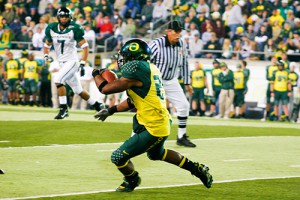I recently wrote a blog post about technology in sports, but I want to focus this post on technology in football and how it benefits the game and, more specifically, the players. With the college football playoff coming up, followed by the Super Bowl, this is a great opportunity to shine a spotlight on technology contributions.
Making College Football Safer
In a recent USA Today article, the author highlights the use of a product by Axon Sports that helps train elite college athletes by converting a team’s playbook into a visual simulation, complete with potential responses from opposing teams. This cognitive training is available for any position except place kicker and punt return. The application uses a tablet-like board to train the player to quickly assess an unfolding situation and react faster and smarter. The benefit of this technology is that a player can repetitively practice several plays without ever having to suit up. This helps a player play smarter while also reducing the risk of injury or concussion. It may be no surprise that the University of Oregon and quarterback Marcus Mariota were among the earliest adopters of this training.
How Fast are They Running?
A recent Boston Globe article spotlights sensor technology worn by almost all NFL players. The sensors emit a signal (at twenty-five times per second) to track and record a player’s speed and distance over time. The sensors use RFID technology to transmit the data points to in-stadium receivers so they can be viewed by announcers and broadcasters almost in real time. This technology is still fairly experimental, but the idea is that the additional data will improve the football viewing experience by allowing fans to do their own analysis and comparisons. When I am watching football data analysis is the furthest thing from my mind, but maybe I am unique that way. I do see how this technology could help players maximize their speed or change their training to increase performance.
What is the Impact?
Helmet impact sensors are, in my opinion, one of the best developments in football. These sensors are still in their infancy but are commercially available for professional and college teams as well as high school and younger players. The sensors record the impact of a collision and assess whether the impact is enough to sideline a player for monitoring, which will hopefully prevent a concussion or future brain injuries. Equipment maker Riddell markets its Speedflex system, which senses and broadcasts impact forces to coaches and trainers who can then make an assessment based on statistics AND qualitative observations. If this can help prevent head injuries in players, I think it is better than any application to enhance viewing that we can develop. This is an excellent use of technology for performance and safety.
Thoughts
You now know about some of the cool technology that can enhance our viewing experience or protect players from injuries. Do you have any ideas for new technologies that would make the game better for you, your favorite player, or the future player sitting next to you? Let me know your thoughts.
 About Kelly Brown
About Kelly Brown
Kelly Brown is an IT professional, adjunct faculty for the University of Oregon, and academic director of the UO Applied Information Management Master’s Degree Program. He writes about IT and business topics that keep him up at night.



converting a team’s playbook into a visual simulation, its really a great inovation..
and the player can repetitively practice several times..
Generally I don’t read article on blogs, but I wish to say that this write-up very forced me to check out and do so! Your writing style has been amazed me. Thanks.